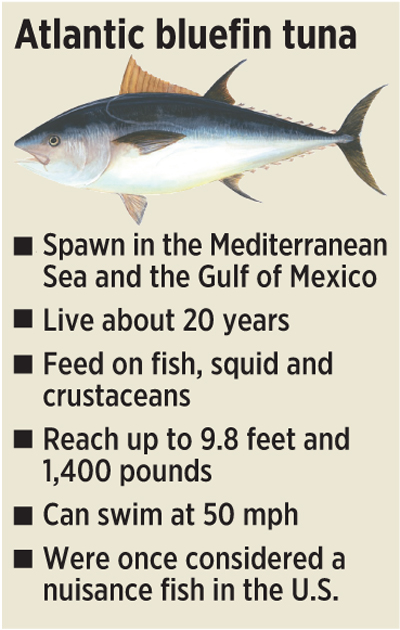PORTLAND — Fishery managers are considering new regulatory alternatives for Atlantic bluefin tuna — majestic fish that can fetch thousands of dollars each — but New England fishermen fear the rules changes could result in smaller quotas for them.
The National Oceanic and Atmospheric Administration has been holding hearings on various options that will be developed into new regulations aimed at protecting and rebuilding tuna populations. The new regulations will go into effect in 2014.
The possible measures focus on bluefin that are inadvertently caught by boats fishing for swordfish, yellowfin tuna and other species in the Gulf of Mexico and off the Eastern Seaboard. Those boats can keep a small number of the bluefin they catch, but have to throw most of them back into the sea, even though they’re dead.
New England fishermen who catch bluefin with rods and reels and harpoons are worried their quotas could be cut to account for the “sins” of other boats with their dead discards, said Rich Ruais, executive director of the Atlantic Bluefin Tuna Association, which represents rod-and-reel and harpoon fishermen.
In a worst-case scenario, he said New England fishermen could lose more than 100 tons of annual quota, a catch worth millions of dollars. Last year, U.S. commercial and recreational fishermen were limited to about 950 metric tons, which equates to about 3,800 fish.
“We’re afraid they’re going to take this quota away from the artisanal rod-and-reel category and artisanal harpoon category and put it into a discard slush fund,” Ruais said.
NOAA held a public hearing on the rules amendment, which modifies existing bluefin management regulations, in Portland on Monday night.
Bluefin tuna, sometimes called the king of the sea, can grow to more than half a ton in size and travel faster than 50 mph while swimming thousands of miles across the Atlantic Ocean.
The fish are lucrative, with fishermen able to get thousands of dollars for a single fish. Most of the fish are shipped to Japan, where their fatty richness is prized for sushi.
The average Atlantic bluefin is about 6 1/2 feet long and weighs about 550 pounds, according to NOAA. A single bluefin tuna caught off northeastern Japan sold for a record 56 million yen, or $736,000, in January in the first auction of the year at Tokyo’s Tsukiji fish market.
Bluefin tuna populations worldwide have come under scrutiny for decades, as heavy fishing pressure has caused their numbers to decline.
They are managed globally by the International Commission for the Conservation of Atlantic Tunas, a multi-governmental organization based in Spain. NOAA sets quotas for commercial and recreational fishermen in the U.S.
NOAA officials are now hearing public comments on a broad spectrum of potential management measures, said Brad McHale, chief of NOAA’s highly migratory species management division in Gloucester, Mass. Public comments will be taken until July 15, and NOAA expects to come back with a proposed rule early next year, he said.
For now, much of the debate is focusing on the tens of thousands of pounds of bluefin that are accidentally caught each year by longliners — fishermen who set long lines with baited hooks near the ocean surface targeting swordfish, yellowfin tuna and other fish, but not bluefin.
One way to reduce the incidental bluefin catch is to make fishermen modify their gear, said Lee Crockett, director of federal fishery policy for the Pew Environment Group in Washington, D.C. Other measures worth considering are to close certain fishing areas when bluefin are present, have stepped-up observation over fishermen and have caps in which longliners would be forced to stop fishing altogether once they catch a specified number of bluefin, he said.
Much of the focus should be on the Gulf of Mexico, he said, because that’s where bluefin spawn between January and June and where the largest of the fish — the “giants,” as they are called — can be found before migrating up the East Coast.
“If (regulators) can get a handle on bluefin bycatch and control it in the longline fishery, that will help rebuild the stocks and make it better for harpooners and the hook-and-line guys,” Crockett said.
All categories of bluefin fishermen are defending themselves to maintain their quotas, said Ernie Panacek, president of the Blue Water Fishermen’s Association, which represents longline boats.
Longline fishermen try to reduce the number of bluefin tuna they catch while targeting other fish, but regulating the bluefin fishery is complex, said Panacek, who is also general manager of Viking Seafood Inc. in Barnegat Light, N.J., which buys fish from 45 boats.
“We’re trying to work amicably with the American Bluefin Tuna Association, but we have to protect our fishery at the same time,” he said. “We’re all in this together and we need to be unified.”
Send questions/comments to the editors.



Success. Please wait for the page to reload. If the page does not reload within 5 seconds, please refresh the page.
Enter your email and password to access comments.
Hi, to comment on stories you must . This profile is in addition to your subscription and website login.
Already have a commenting profile? .
Invalid username/password.
Please check your email to confirm and complete your registration.
Only subscribers are eligible to post comments. Please subscribe or login first for digital access. Here’s why.
Use the form below to reset your password. When you've submitted your account email, we will send an email with a reset code.